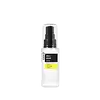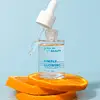What's inside
What's inside
 Key Ingredients
Key Ingredients

 Benefits
Benefits

 Concerns
Concerns

 Ingredients Side-by-side
Ingredients Side-by-side

Water
Skin ConditioningButylene Glycol
HumectantGlycerin
HumectantNiacinamide
SmoothingSaccharide Isomerate
HumectantBetaine
HumectantSodium Hyaluronate
HumectantOrbignya Oleifera Seed Oil
EmollientTriethanolamine
BufferingPanthenol
Skin ConditioningGlycereth-26
HumectantCarbomer
Emulsion StabilisingSimmondsia Chinensis Seed Oil
EmollientLimnanthes Alba Seed Oil
Skin ConditioningSorbitan Isostearate
EmulsifyingButyrospermum Parkii Butter
Skin ConditioningIsononyl Isononanoate
EmollientPolysorbate 60
EmulsifyingRosa Canina Fruit Oil
EmollientOlea Europaea Fruit Oil
MaskingMacadamia Integrifolia Seed Oil
Skin ConditioningDimethicone
EmollientSolanum Lycopersicum Fruit Extract
AntioxidantLilium Tigrinum Extract
Skin ConditioningMyrciaria Dubia Fruit Extract
Skin ConditioningEuterpe Oleracea Fruit Extract
Phaseolus Radiatus Sprout Extract
HumectantCamellia Sinensis Leaf Extract
AntimicrobialPanax Ginseng Root Extract
EmollientAloe Barbadensis Leaf Extract
EmollientHoney
HumectantRosa Multiflora Fruit Extract
MaskingGardenia Florida Fruit Extract
Skin ConditioningScutellaria Baicalensis Root Extract
AstringentLigustrum Japonicum Fruit Extract
Skin ConditioningHydrogenated Lecithin
EmulsifyingDisodium EDTA
Thymus Vulgaris Extract
PerfumingBuddleja Davidii Extract
Skin ConditioningTocopheryl Acetate
AntioxidantAscorbic Acid
AntioxidantPhenoxyethanol
PreservativeEthylhexylglycerin
Skin ConditioningParfum
MaskingWater, Butylene Glycol, Glycerin, Niacinamide, Saccharide Isomerate, Betaine, Sodium Hyaluronate, Orbignya Oleifera Seed Oil, Triethanolamine, Panthenol, Glycereth-26, Carbomer, Simmondsia Chinensis Seed Oil, Limnanthes Alba Seed Oil, Sorbitan Isostearate, Butyrospermum Parkii Butter, Isononyl Isononanoate, Polysorbate 60, Rosa Canina Fruit Oil, Olea Europaea Fruit Oil, Macadamia Integrifolia Seed Oil, Dimethicone, Solanum Lycopersicum Fruit Extract, Lilium Tigrinum Extract, Myrciaria Dubia Fruit Extract, Euterpe Oleracea Fruit Extract, Phaseolus Radiatus Sprout Extract, Camellia Sinensis Leaf Extract, Panax Ginseng Root Extract, Aloe Barbadensis Leaf Extract, Honey, Rosa Multiflora Fruit Extract, Gardenia Florida Fruit Extract, Scutellaria Baicalensis Root Extract, Ligustrum Japonicum Fruit Extract, Hydrogenated Lecithin, Disodium EDTA, Thymus Vulgaris Extract, Buddleja Davidii Extract, Tocopheryl Acetate, Ascorbic Acid, Phenoxyethanol, Ethylhexylglycerin, Parfum
Water
Skin ConditioningGlycerin
HumectantPropylene Glycol
Humectant3-O-Ethyl Ascorbic Acid
Skin ConditioningNiacinamide
SmoothingBetaine
HumectantSerine
MaskingTaurine
BufferingSodium Hyaluronate
HumectantGlycyrrhiza Uralensis Root Extract
Skin ConditioningGentiana Scabra Root Extract
Skin ConditioningChamomilla Recutita Flower Extract
MaskingCentella Asiatica Root Extract
Skin ConditioningRosmarinus Officinalis Extract
AntimicrobialCarbomer
Emulsion StabilisingHydroxyethylcellulose
Emulsion StabilisingTriethanolamine
BufferingDisodium EDTA
PEG-40 Hydrogenated Castor Oil
EmulsifyingPhenoxyethanol
PreservativeEthylhexylglycerin
Skin ConditioningParfum
MaskingWater, Glycerin, Propylene Glycol, 3-O-Ethyl Ascorbic Acid, Niacinamide, Betaine, Serine, Taurine, Sodium Hyaluronate, Glycyrrhiza Uralensis Root Extract, Gentiana Scabra Root Extract, Chamomilla Recutita Flower Extract, Centella Asiatica Root Extract, Rosmarinus Officinalis Extract, Carbomer, Hydroxyethylcellulose, Triethanolamine, Disodium EDTA, PEG-40 Hydrogenated Castor Oil, Phenoxyethanol, Ethylhexylglycerin, Parfum
Ingredients Explained
These ingredients are found in both products.
Ingredients higher up in an ingredient list are typically present in a larger amount.
Betaine is a common humectant (a substance that promotes retention of moisture). It's known to be gentle on the skin and can help balance hydration.
This ingredient is best for improving hydration and soothing irritated skin. Studies also show it helps even out skin tone.
Fun fact: Betaine is naturally created in the skin and body. The kind found within cosmetic products can be either plant-derived or synthetic.
Another name for betaine is trimethylglycine.
Learn more about BetaineCarbomer is a polymer of acrylic acid. Its main role is to create a gel consistency.
A high amount of carbomer can cause pilling or balling up of products. Don't worry, most products contain 1% or less of carbomer.
Disodium EDTA plays a role in making products more stable by aiding other preservatives.
It is a chelating agent, meaning it neutralizes metal ions that may be found in a product.
Disodium EDTA is a salt of edetic acid and is found to be safe in cosmetic ingredients.
Learn more about Disodium EDTAEthylhexylglycerin (we can't pronounce this either) is commonly used as a preservative and skin softener. It is derived from glyceryl.
You might see Ethylhexylglycerin often paired with other preservatives such as phenoxyethanol. Ethylhexylglycerin has been found to increase the effectiveness of these other preservatives.
Glycerin is already naturally found in your skin. It helps moisturize and protect your skin.
A study from 2016 found glycerin to be more effective as a humectant than AHAs and hyaluronic acid.
As a humectant, it helps the skin stay hydrated by pulling moisture to your skin. The low molecular weight of glycerin allows it to pull moisture into the deeper layers of your skin.
Hydrated skin improves your skin barrier; Your skin barrier helps protect against irritants and bacteria.
Glycerin has also been found to have antimicrobial and antiviral properties. Due to these properties, glycerin is often used in wound and burn treatments.
In cosmetics, glycerin is usually derived from plants such as soybean or palm. However, it can also be sourced from animals, such as tallow or animal fat.
This ingredient is organic, colorless, odorless, and non-toxic.
Glycerin is the name for this ingredient in American English. British English uses Glycerol/Glycerine.
Learn more about GlycerinNiacinamide is a multitasking form of vitamin B3 that strengthens the skin barrier, reduces pores and dark spots, regulates oil, and improves signs of aging.
And the best part? It's gentle and well-tolerated by most skin types, including sensitive and reactive skin.
You might have heard of "niacin flush", or the reddening of skin that causes itchiness. Niacinamide has not been found to cause this.
In very rare cases, some individuals may not be able to tolerate niacinamide at all or experience an allergic reaction to it.
If you are experiencing flaking, irritation, and dryness with this ingredient, be sure to double check all your products as this ingredient can be found in all categories of skincare.
When incorporating niacinamide into your routine, look out for concentration amounts. Typically, 5% niacinamide provides benefits such as fading dark spots. However, if you have sensitive skin, it is better to begin with a smaller concentration.
When you apply niacinamide to your skin, your body converts it into nicotinamide adenine dinucleotide (NAD). NAD is an essential coenzyme that is already found in your cells as "fuel" and powers countless biological processes.
In your skin, NAD helps repair cell damage, produce new healthy cells, support collagen production, strengthen the skin barrier, and fight environmental stressors (like UV and pollution).
Our natural NAD levels start to decline with age, leading to slower skin repair, visible aging, and a weaker skin barrier. By providing your skin niacinamide, you're recharging your skin's NAD levels. This leads to stronger, healthier, and younger looking skin.
Another name for vitamin B3 is nicotinamide. This vitamin is water-soluble and our bodies don't store it. We obtain Vitamin B3 from either food or skincare. Meat, fish, wheat, yeast, and leafy greens contain vitamin B3.
The type of niacinamide used in skincare is synthetically created.
Learn more about NiacinamideParfum is a catch-all term for an ingredient or more that is used to give a scent to products.
Also called "fragrance", this ingredient can be a blend of hundreds of chemicals or plant oils. This means every product with "fragrance" or "parfum" in the ingredients list is a different mixture.
For instance, Habanolide is a proprietary trade name for a specific aroma chemical. When used as a fragrance ingredient in cosmetics, most aroma chemicals fall under the broad labeling category of “FRAGRANCE” or “PARFUM” according to EU and US regulations.
The term 'parfum' or 'fragrance' is not regulated in many countries. In many cases, it is up to the brand to define this term.
For instance, many brands choose to label themselves as "fragrance-free" because they are not using synthetic fragrances. However, their products may still contain ingredients such as essential oils that are considered a fragrance by INCI standards.
One example is Calendula flower extract. Calendula is an essential oil that still imparts a scent or 'fragrance'.
Depending on the blend, the ingredients in the mixture can cause allergies and sensitivities on the skin. Some ingredients that are known EU allergens include linalool and citronellol.
Parfum can also be used to mask or cover an unpleasant scent.
The bottom line is: not all fragrances/parfum/ingredients are created equally. If you are worried about fragrances, we recommend taking a closer look at an ingredient. And of course, we always recommend speaking with a professional.
Learn more about ParfumPhenoxyethanol is a preservative that has germicide, antimicrobial, and aromatic properties. Studies show that phenoxyethanol can prevent microbial growth. By itself, it has a scent that is similar to that of a rose.
It's often used in formulations along with Caprylyl Glycol to preserve the shelf life of products.
Sodium Hyaluronate is hyaluronic acid's salt form. It is commonly derived from the sodium salt of hyaluronic acid.
Like hyaluronic acid, it is great at holding water and acts as a humectant. This makes it a great skin hydrating ingredient.
Sodium Hyaluronate is naturally occurring in our bodies and is mostly found in eye fluid and joints.
These are some other common types of Hyaluronic Acid:
Learn more about Sodium HyaluronateTriethanolamine is an emulsifier and pH adjuster. It is created using ethylene oxide and ammonia. This gives Triethanolamine a nitrogen core and a similar scent to ammonia.
As an emulsifier, it prevents ingredients from separating and enhances texture by adding volume to a product.
PH adjusters are common in cosmetic products. The pH of a product can affect the effectiveness of other ingredients. A product with a high pH may also irritate the skin.
Learn more about TriethanolamineWater. It's the most common cosmetic ingredient of all. You'll usually see it at the top of ingredient lists, meaning that it makes up the largest part of the product.
So why is it so popular? Water most often acts as a solvent - this means that it helps dissolve other ingredients into the formulation.
You'll also recognize water as that liquid we all need to stay alive. If you see this, drink a glass of water. Stay hydrated!
Learn more about Water